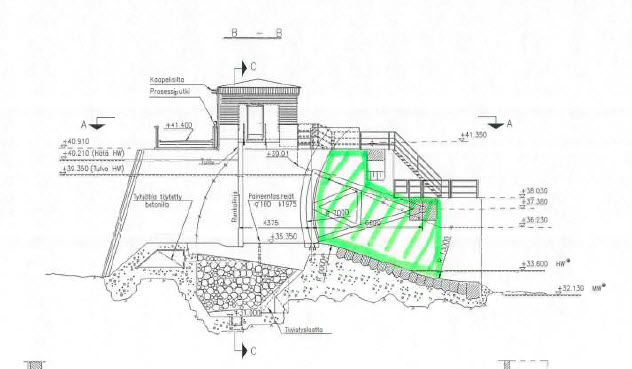Community Tip - Want the oppurtunity to discuss enhancements to PTC products? Join a working group! X
- Subscribe to RSS Feed
- Mark Topic as New
- Mark Topic as Read
- Float this Topic for Current User
- Bookmark
- Subscribe
- Mute
- Printer Friendly Page
How to calculate steel stripe warming when subject to electric current ?
- Mark as New
- Bookmark
- Subscribe
- Mute
- Subscribe to RSS Feed
- Permalink
- Notify Moderator
How to calculate steel stripe warming when subject to electric current ?
Hello all,
I'm in need to design a solution to prevent existing concrete surface to collect ice, when there is sparkling
water flying around. This is actually dam and the surfaces are the sides of it and dam is slightly leaking or
opened to let water run, so that there is lot of water drops everywhere.
Now I got idea to clean these concrete surfaces by high pressure water jets, glue RST-plate stripes side by side
using epoxy, and finally connect these plate to electric system to warm them max up to 30 deg. Celsius and
surrounding climate is below Zero.
The total area in question is ca. 30m2 per one dam and I have three dams.
My question is how to calculate the thickness of the plate, if they are f.ex. width=200 and length 5000
and what kind of current it might need??
Better off, if someone can give formula where these values could be calculated by myself? ;>)
Best Regards Matti Pitkanen
- Labels:
-
Other
- Tags:
- steel stripe warming
- Mark as New
- Bookmark
- Subscribe
- Mute
- Subscribe to RSS Feed
- Permalink
- Notify Moderator
May be this (pics 18.8-18.12) will be a start pictures for you
- Mark as New
- Bookmark
- Subscribe
- Mute
- Subscribe to RSS Feed
- Permalink
- Notify Moderator
You've got quite a problem. Actually, several of them.
- You need to figure out (guess, actually) how much heat you need to keep the plates warm. This is where what Valery pointed you at may come in handy, although there are so many variables in your problem (how much "sparkling water" do you have to melt? how much water is leaking over the plates? Is there wind or still air?) that determining heating requirements may be the largest issue.
- Electric heating isn't challenging. If you know what the heat flux per unit area you need then you can figure current density for a given resistivity. (Resistivity is a material property, I didn't say resistance.) From current density and plate width you can get thickness. From area, length and resistivity you get resistance, from resistance and current you get voltage.
It's going to be expensive!
- Mark as New
- Bookmark
- Subscribe
- Mute
- Subscribe to RSS Feed
- Permalink
- Notify Moderator
Hi Matti,
I would use a so-called electric water heater, commonly used in homes where the gas network does not reach them, and with an electric pump, distribute hot water into a network of pipes or serpentine arranged on the walls where ice forms, a bit like you do to heat the floor. Heating with current could be dangerous.
- Mark as New
- Bookmark
- Subscribe
- Mute
- Subscribe to RSS Feed
- Permalink
- Notify Moderator
Hi F.M.
Spraying hot water is no solution, due to large area and eccessive heat loss, I think.
Direct surface warming is much more effective, because it prevents the iceing on surface.
We have just now an other rebuild project where new vertically moving steel-made dam plate
ca. 5 x 4 m2 slides between U-shaped RST-made guides on both sides. These guides are
electrically heated. Me being a structural engineer, have no idea ( yet ) what is the
voltage, AC/DC-mode or current, but I have been told, that it is working well and can be made
for my idea too. ;>)
I have been asked to do preliminary design for cost estimate and budget, so I should know
with some accuracy the plate thickness.
BR Matti
- Mark as New
- Bookmark
- Subscribe
- Mute
- Subscribe to RSS Feed
- Permalink
- Notify Moderator
You can calculate the resistance of a mild steel plate if you know the dimensions. So for voltage you can get current, etc.
- Mark as New
- Bookmark
- Subscribe
- Mute
- Subscribe to RSS Feed
- Permalink
- Notify Moderator
Thanks Fred, now I can see some direction for my exams ;>)
How do you see my task: one big plate or several stripes ?
I'll come back next week, tomorrow in court as expert and week-end in Netherlands and back on Monday.

BR Matti
- Mark as New
- Bookmark
- Subscribe
- Mute
- Subscribe to RSS Feed
- Permalink
- Notify Moderator
Trying to pass electricity directly thru structural steel seems to me to be difficult and risky. There would be many opportunities for unintentional current paths.
I suggest that you consult with a good electrical power engineer--sooner rather than later. If there's already a system in place that works, who designed and installed that?
- Mark as New
- Bookmark
- Subscribe
- Mute
- Subscribe to RSS Feed
- Permalink
- Notify Moderator
Hi Matti,
I said to heat the surface with a conventional heating system. The heat conductive fluid , flowing in the appropriate pipes and radiator, could be high temperatur oil instead of water.





